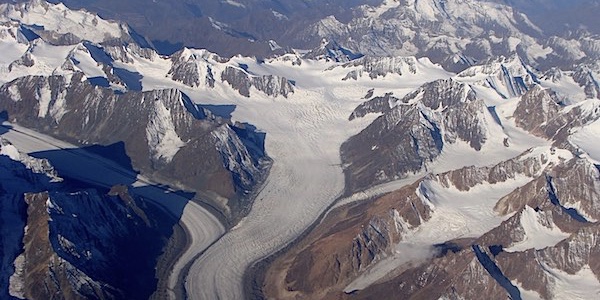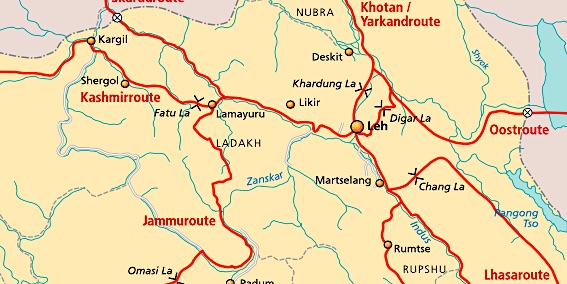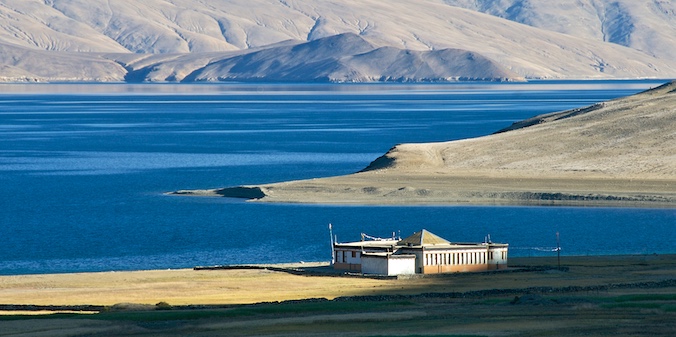LADAKH - RUMTSE to TSOMORIRI TREK
Tour - 18 days/ 10 days trekking
RUMTSE to TSOMORIRI TREK
Tour - 18 days/ 10 days trekking
About LADAKH
Ladakh is a part of the Indian Himalayas It is located between the Kunlun mountain range in the north and the main Himalayas to the south. Although part of India now, and earlier of the princely state of Kashmir, Ladakh has been an independent kingdom for almost 900 years.
Ladakh is well-known for its starkly beautiful mountain scenery. As a result of its location in the rain shadow of the main Himalayan Range its climate is extremely dry, and due to the high altitude – most valleys are situated at 3300m or higher – winters can be extremely cold. Summers, however, are generally pleasant if not warm and sunny. Ladakh is inhabited by a mix of Indo-Aryan and Tibetan people. Especially the latter, with their colourful buddhist culture, have given the region the nickname of ‘Little Tibet.’
Ladakh in the narrower sense is the Indus Valley with adjacent areas. It is bordered by two mountain ranges: in the northeast by the Ladakh Range, in the southwest by the Zanskar Range. The area around the capital Leh, and further upstream towards Tibet, is referred to as Upper Ladakh. Lower Ladakh is the area further downstream to Kargil, where the Indus enters Pakistan.
The remoter areas of Zanskar, Nubra and Rupshu are now seen as regions of Ladakh. In the past, these areas were sometimes part of Ladakh, sometimes not. They can be visited from Leh by car or on foot. The latter would be your means of transport, if you are up to it. Because, while jeep trips in Ladakh are very rewarding indeed, trekking will give you an even in-depth experience of the land and the people, with the added bonus of a total renovation of body and soul.
Ladakh can be reached by air or overland. On this tour you fly in and out. In case you have enough time available, we strongly recommend to take the overland route, in which you travel by train and car to Ladakh through Manali, in the Himalayan state of Himachal Pradesh. This is one of the greatest car journeys in the world.
Region
Ladakh
(India)
Best Time
July - Sept.
No. Of Days
18 days,
8 + 2 days trek
Trip Character
Trekking tour
Sleeping Altitude
3200 - 5160 m.
Trek Character
Camping trek
Level: 4
Price
INR XXX/ $ XXX
ABOUT THIS TOUR
The remote high plateau of Changthang (meaning ‘northland’) stretches from western Tibet into eastern Ladakh. This region, known as the land of the nomads, will give you an experience to last a lifetime. You’ll see the nomads’ traditional lifestyle and maybe share a cup of butter tea in one of their black yak-hair tents, and pass through incredibly stark mountain desert landscapes before you’ll descend to the oval-shaped banks of lake Tsomoriri. This beautiful lake keeps changing its color with the light, from turquoise to deep cobalt blue.
The area that you’ll pass through is also an important wildlife sanctuary, harboring snow leopards and wild horses (kyang), as well as many species of birds.
This trek is one of the highest in Ladakh. One doesn’t get to sleep lower then 4400m – 2 nights even above 5000m – and the passes are up to 1000 m higher. An excellent condition is required, as well as a good acclimatization before starting out.
Before discovering the high altitude plateaus on the main trek, we’ll take you to some parts of the Indus Valley (Ladakh proper, near Leh) with its magnificent gompas (monasteries). And, to get into the swing of trekking, before setting out on the main trek, you’ll do a two-day easy trek in the so-called Sham area, walking between awesomely bright-green oases set amidst bare and forbidding, but very colorful mountains. If there is one thing that impresses here, it is the way people have been able to eke out a very decent living in an utterly hostile climate with the help of an ingenious irrigation system, a hardy strain of barley, and an incredible amount of optimism.
YOUR custom-made TRIP
The tour described here, as well as the other ones on our website, are mainly meant as suggestions. We would be happy to offer you a travel proposal that fully meets your personal demands and expectations. That means that you choose where you want to go, what level of accommodation and type of transport you want and what activities you prefer.
Please let yourself be inspired by this and other trips on our website and then drop us a line (or call us up) to explain your travel wishes. We will be happy to help you put together the perfect trip. You can send us an e-mail or call us over Whatsapp.
EXTENSIONS & VARIATIONS
Apart from the tour as described here, you could consider the following add-ons and changes:
- Spend six days visiting Nubra, Pangong Lake and Shyok after the trek. See here.
- Do an even longer trek. After reaching Korzok, you can continue along Tsomoriri and cross the 5400m high Parang La into Spiti. This will give you more of the same grandiose, stark Changtang landscape plus the experience of reaching a different area all together, Spiti. We recommend to do this trek in the reverse direction. See here.
- Spend a day rafting on the Indus. There are different grades available, so there is the easy but fun to do level as well. Professional oarsmen will be with you in any case. You will be picked up from your hotel and dropped off there again at the end of the day, a pic-nic lunch is included
ITINERARY
-
Day 1: Flight Delhi - Leh
The flight from Delhi to Leh takes only 1 hour but on a clear day, is breathtaking. Stepping down from the aircraft you may feel the altitude, but even if you don’t, it is very wise to take the rest of the day off. Stay at the hotel or at best walk around Leh bazar. -
Day 2 & 3: In Leh
If you wake up today without a headache you may consider yourself fit to go on not too strenuous walks/excursions in and around Leh. Else it is better to stay at the hotel another day. Altitude: 3500m. -
Day 4: Leh - Likir; Trekking to Yangthang (2 h drive, 3 - 4 h walking)
After a transfer to Likir, and a look at the picturesque Likir Gompa, perched on a hillock, you'll start you 4-day trek. Today you cross a low pass to picturesque Yangthang. Altitude 3500 → 3600 → 3720 → 3630m. -
Day 5: Trekking Yangthang - Ang & drive to Uletokpo (4 - 5 h walking, 1.5 h drive)
Today is a slightly longer walk. You'll pass the 3750m high Sermanchan La (3750m) to the beautiful villages of Hemis Shukpachan and Ang. Here, the car will pick you up for a short transfer to a pleasant accommodation overlooking the Indus River. Altitude 3630 → 3750 → 3480 → 3060m. -
Day 6: Ule Tokpo - Lamayuru - Alchi – Leh (4 - 5 h)
Today you'll ravel further downstream along the Indus to the bautiful monastery of Lamayuru. After visiting this gompa, and the even more ancient Alchi Gompa, you'll return to Leh. Altitude 3060 → 3530 → 3500m. -
Day 7: Leh - Rumtse & Trekking Rumtse - Kyamar (drive 1 h; walking 3 - 4 h)
From Leh, you drive to Rumtse, the last village on the way to Manali. Here the trek starts. Today is a relatively short walk on rather flat terrain to aid acclimatization. Camp in a lush meadow near a spring at 4050m. -
Day 8: Trekking Kyamar – Valley Camp (3.5 - 4.5 h)
A gradual ascent leads to our first pass, the Kumur La (5130 m), which gives a spectacular view of the Changthang range with its colorful mountains. A short descent leads to a valley with a brook, where you camp for the night. -
Day 9: Trekking Valley Camp - Tisaling (2.5 - 3.5 h)
Due to the altitude, your sleep may have been light or even seriously disrupted. That's why today's walk is another relatively short one. There's a gradual climb to Mandalchan La (5230 m), followed by an easy descend to camp at the high pastureland of Tisaling (5030m). -
Day 10: Trekking Tisaling - Pongunagu (6 h)
Today’s pass is even higher. It takes about 3 hours to reach the Shinbuk La (5300 m), the reward are incredible views. Here, you may encounter nomads with their sheep, goats and yak. A long, gradual descent leads to your camp in the vast open plain of Tsokar Lake (4550m). -
Day 11: Trekking Pongunagu - Nuruchan (5 - 6h)
Today is an easy day, as you follow a small road around Tsokar Lake, and then gradually climb to camp above the small settlement (semi-nomadic) of Nuruchan (4630m). -
Day 12: Trekking Nuruchan - Rajungkaru (3 - 4 h)
Another gradual climb brings you on top of the Horlam Kongka La (4900m), which seems a mere hill in this immense wide and high landscape. Camp is along a stream near a nomad camp at Rajungkaru (4950m). -
Day 13: Trekking Rajungkaru - Gyama Lhoma (6 - 7 h)
Today’s pass, the Kyamayuri La (5425 m), is a more challenging in nature, but the magnificent view from the top makes it (again) worth the efforts. After descending, you cross another, easier pass before you descend to your camp near a wide stream at Gyama Lhoma. At 5160 m, this is a cold place and serious frost can happen here any time of the year. -
Day 14: Trekking Gyama Lhoma - Korzok/ Tsomoriri (5.5 - 6.5 h)
Another climbing day will bring you atop the highest and final pass on the trek, the Yalung Nyaulung La (5450 m). From the pass you will finally het a view of your destination, the cobalt-blue lake Tsomoriri. You descend along Korzok Phu, the summer pasture of the Korzok people to the town of Korzok, where you’ll stay in a tented (fixed) camp . -
Day 15: At Korzok
Today you can relax and explore Korzok, for instance by visiting th local monastery, and stroll along the beautiful lake. -
Day 16: Korzok - Leh (6 - 7 h)
A long drive will take you back to Leh, first through the familaira landscape of wide valleys with flocks of sheep, then along the horge of the Indus River to Karu, and on to Leh. -
Day 17: In Leh
A last day in Leh to buy souvenirs and to get organised for the trip back home. Or to go on a rafting trip on the Indus River. -
Day 18: Flight Leh - Delhi
After breakfast, our shikara will take you to the shore, where the taxi for the airport, bus or railway station or your onward journey to Ladakh will be waiting.
HIGHLIGHTS OF THIS TOUR
Flight to Leh


LEH
CARAVAN ROADS OF LADAKH


SHAM TREK
LOWER INDUS VALLEY (WEST)


ALCHI GOMPA

Rumtse - Tsomoriri Trek
NOMADS of CHANGTANG


SALTY LAKES OF CHANGTANG
ASSES or HORSES?




